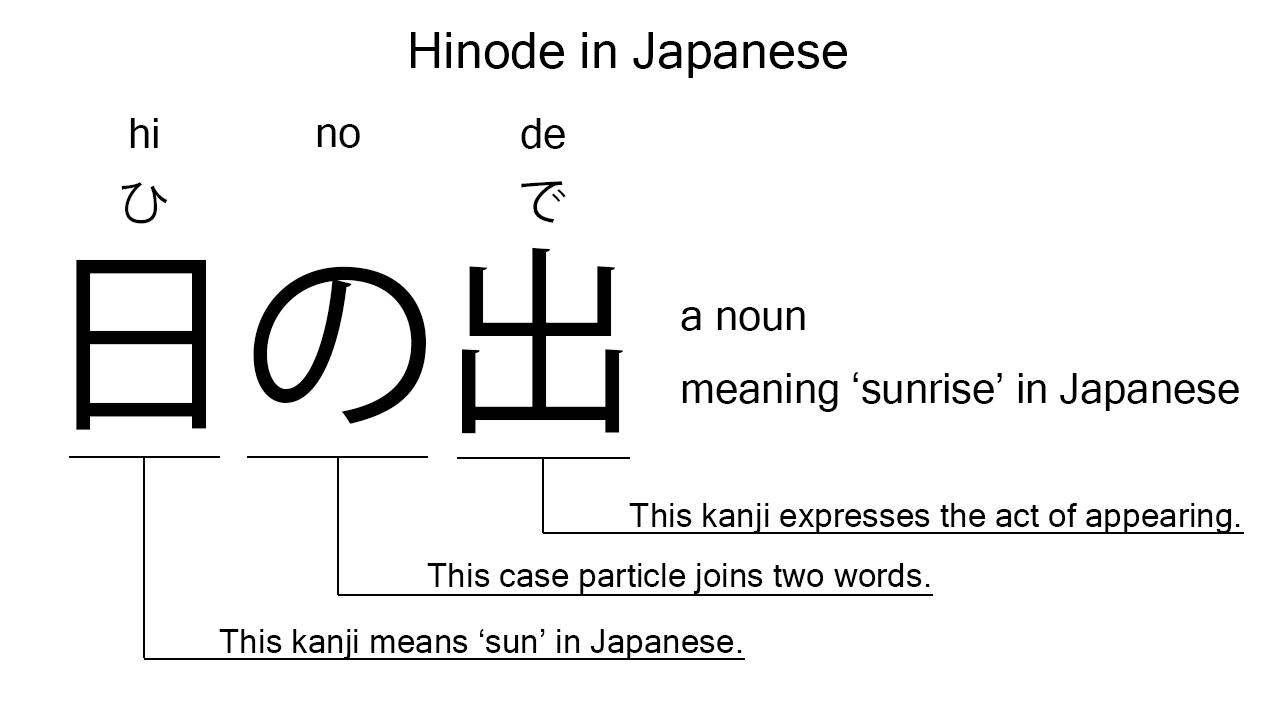What does “hinode” mean in Japanese?
Native speakers say “hinode” to mean ‘sunrise’ in Japanese. Perhaps, some Japanese learners know this word as it is sometimes used in Japanese movies, songs, novels, manga, anime, and the like. In this blog post, however, I will explain this word in detail based on its kanji expressions. And also, I will explain how to use it through example sentences. My explanations would help Japanese learners to understand “hinode” more clearly. Then, let’s get started!
Contents
Definition and meaning of “hinode”
Let me start with the definition and meaning of “hinode”.
- hinode – 日の出 (ひので) : a noun meaning ‘sunrise’ in Japanese.
The definition and meaning are very simple and clear, I think. To understand this noun more clearly, however, let me explain its kanji expression in detail.
Hinode in kanji
The kanji expression of “hinode” consists of the following two kanji characters and one particle:
- 日 : a kanji character widely used to mean ‘day’, ‘sun’, or such in Japanese.
- の : a case particle used to join two nouns or noun equivalent words. Normally, the first one can work as a modifier to describe the second.
- 出 : a kanji character widely used to express the act of going out, coming out, or appearing.
From these three components, we can understand that “hinode” literally means ‘sun appearing’ in Japanese. This literal interpretation is not completely in line with the meaning, but still very understandable, I think. The sun rising is more or less the same as the sun appearing.

When we meet new kanji expressions, we should check their components in detail to understand their meanings clearly and deeply. In many cases, components tell us a lot about the meanings of the expressions they form. Actually, here, we could get the better understanding of “hinode” through the detailed check above.
So far, I’ve explained the definition and meaning of “hinode” and its kanji expression in detail. Then, let me explain how to use it through the example sentences below.
Example #1: how to say “sunrise” in Japanese
kesa hinode ga totemo utsukushikat ta – 今朝日の出がとても美しかった (けさひのでがとてもうつくしかった)
The sunrise was very beautiful this morning.
Below are the new words used in the example sentence.
- kesa – 今朝 (けさ) : a noun meaning ‘this morning’ in Japanese. This can also work as an adverb almost anywhere in a sentence. In the example, this works as an adverb to say “this morning” in Japanese.
- ga – が : a case particle used to make the subject word or the object word in a sentence. In the example, this is used after “hinode” to make the subject in the sentence.
- totemo – とても : an adverb of degree meaning ‘very’, ‘much’, ‘so’, or such in Japanese. In the example, this works before “utsukushikat ta” to emphasize its meaning.
- utsukushikat – 美しかっ (うつくしかっ) : one conjugation of the i-adjective, “utsukushii“, which means ‘beautiful’ in Japanese. In the example, it has been conjugated for the better connection with its following word.
- ta – た : an auxiliary verb used after a verb, adjective, or auxiliary verb to make its past tense form. Probably, this is well known as a part of Japanese ta form. In the example, this is use after “utsukushikat” to make its past tense form, “utsukushikat ta”.
This is a typical usage of “hinode”. When we want to mean ‘sunrise’ in Japanese, this noun is a very good option.
Example #2: another usage of “hinode”
watashi wa hinode no shashin wo tot ta – 私は日の出の写真を撮った (わたしはひのでのしゃしんをとった)
I took pictures of the sunrise.
Below are the new words used in the example sentence.
- watashi – 私 (わたし) : a pronoun meaning ‘I’ in Japanese.
- wa – は : a binding particle working as a case marker or topic marker. In the example, this works after “watashi” to make the subject in the sentence.
- no – の : the same as used in “hinode”. In this example, this is used to join “hinode” and “shashin”. The formed phrase literally means ‘pictures of the sunrise’ in Japanese. Word orders in Japanese and English are different, but the role of this case particle is similar to that of the English preposition, “of”.
- shashin – 写真 (しゃしん) : a noun meaning ‘picture’ in Japanese. This can also work as plural. Learn more about Japanese plural.
- wo – を : a case particle used to make the object word in a sentence. In the example, this is used after “hinode no shashin” to make the object in the sentence.
- tot – 撮っ (とっ) : one conjugation of the verb, “toru”, which means ‘to take’, ‘to film’, ‘to shoot’, or such in Japanese. In the example, it has been conjugated for the better connection with its following word.
This is another typical usage of “hinode”. In this example, it works as a part of the noun phrase, “hinode no shashin”, which means ‘pictures of the sunrise’ in Japanese.
Summary
In this blog post, I’ve explained the definition and meaning of ‘hinode’ in detail based on its kanji expression. And also, I’ve explained how to use them through example sentences. Let me summarize them as follows.
- hinode – 日の出 (ひので) : a noun meaning ‘sunrise’ in Japanese. These three characters literally mean ‘sun appearing’ in Japanese. This literal interpretation is not completely in line with the meaning, but still very understandable, I think. The sun rising is more or less the same as the sun appearing.
Hope my explanations are understandable and helpful for Japanese learners.